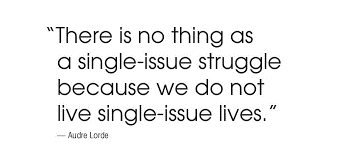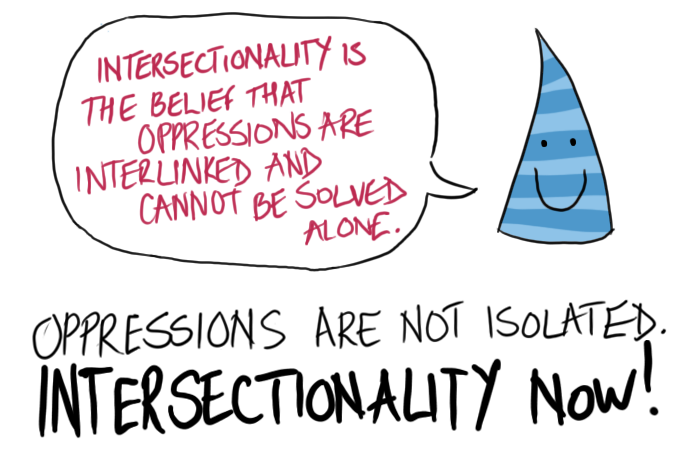Abortion is not “single issue”: The need for Intersectionality in Abortion Conversations in India
– by Garima Srivastava

Intersectionality as a concept was coined by Crenshaw in 1989; “intersectionality was intended to address the fact that the experiences and struggles of women of colour fell between the cracks of both feminist and anti-racist discourse. Crenshaw argues, that theorists need to take both gender and race on board and show how they interact to shape the multiple dimensions of Black women’s experiences” (Davis 2008: 68).
Today intersectionality is proclaimed as one of the most important contributions of feminist theories, mainly because it helps us to move beyond the obvious and see various ways in which multiple oppressions and power relations interact to shape multiple dimensions of women’s experience.
An individual is not a one-dimensional being and its location at any point in time is informed by multiple identities. Women experience discrimination differently based on their situation. Intersectionality is therefore about social, political, cultural and economic processes that affect one’s life simultaneously.
In India abortion is legal under the Medical Termination of Pregnancy Act (MTP Act) 1971 under certain conditions, however, the ambiguity around the same has resulted in its misinterpretation and denial of access to women.
On February 28, 2017, the court refused to allow an abortion for a woman who was 26 week pregnant with a foetus which would be born with Down’s syndrome (Rai and Sheikh 2017). Later that year a 35 year old HIV positive woman who was sexually assaulted was denied abortion by the apex court (Ibid 2017), A 10-year-old girl who was raped by her uncle, and found to be 24 weeks pregnant was denied abortion by the court on the grounds that she was too far into pregnancy and abortion at this stage will be a risk to the health of the girl and the ‘child’ (BBC News 2017).
The additive approach of the current law (which is also reflected in the International law) fails to take into account gender, caste, class and age of women and how these experiences impact differently their lived realities. Currently, the Human Rights treaties are fragmented into various treaties, which delve into each issue separately. So we have a Convention on Child Rights, another one on Disability and another looking into issues specific to Women and so on.
But in practice, the issues are not categorized and an experience of discrimination or abuse may be multifaceted based on an individual’s location at the intersection of oppression and power relations. Through an intersectional framework, human rights treaties and conventions can be made more meaningful.
International law needs to take cognizance of the role of state ideologies and personal beliefs and biases of lawmakers and attitudes of providers that are representatives of gendered institutions. What needs to be further explored is the impact of International Human Rights Law on the ground and its interaction with local legal systems.

Individuals experience violence and injustice differently depending on their location in the nexus of power relations and oppression. Intersectionality allows us to see how women experience institutional gendered discrimination and how it intersects with their class and social positioning. It doesn’t provide ready-made solutions but it does allow us to ask the right questions. Through intersectionality “traditional human rights practice and remedies can then be examined to see in what ways they need to be modified, expanded, and transformed to take greater account of such differing realities” (Bunch 2002: 116)
Only by taking cognizance of these structures and relations of power can we provide holistic solutions. It’s, therefore, time to reflect on the inadequacy of laws to provide social justice.
Human rights are a spectrum and not a monolith. Thus, realizing a full range of human rights requires moving beyond existing binaries and working towards an intersectional approach to human rights that is conscious of the needs of the most marginalized in society and is flexible to adapt these needs.
References:
BBC News (2017) ‘Indian court rejects abortion for 10-year-old rape victim’ 28 Jul 2017 (Accessed on 30 June 2018) http://www.bbc.com/news/world-asia-india-40753409
Bunch, C. (2002) ‘Human Rights at the Intersection of Race and Gender’, in R. Raj et al. (eds), Women at the Intersection: Indivisible Rights, Identities, and Oppressions (pp. 111-118). New Jersey: Centre for Women’s Global Leadership, Rutgers University
Davis, K. (2008) ‘Intersectionality as a buzzword: A sociology of science perspective on what makes a feminist theory successful’, Feminist Theory 9(1): 67-85.
Rai, S and Sheikh, S. (2017) ‘India’s Abortion Laws Need to Change and in the Pro-Choice Direction’ The Wire May 11, 2017 (Accessed on 05 July 2018) https://thewire.in/gender/abortion-pregnancy-law-india






